A dental matrix is a band that adapts to the surface of the tooth to be restored and reproduces the anatomical contours, replacing the missing wall or walls and containing the restorative material to give an anatomical shape to the interproximal walls and to obtain adequate contact points.
Sometimes choosing a matrix band is not an easy task and that is why in this article we want to tell you how you can select the most appropriate one for each of your clinical cases and what are the factors to consider in your choice. Are you ready?
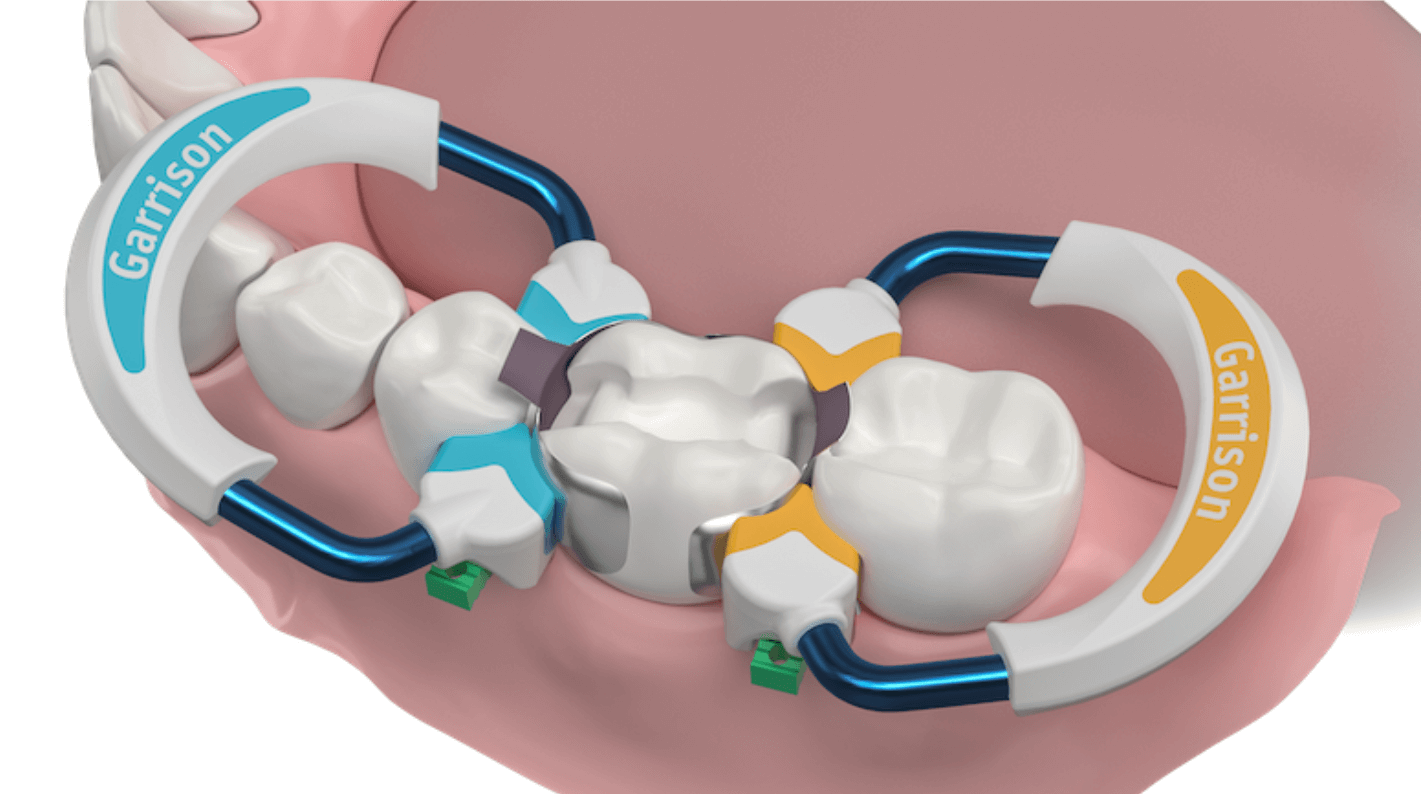
The use of matrices in dentistry
The use of matrices in dentistry allows us to reconstruct teeth according to their original morphology, maintaining their shape, contour and contact points, in order to preserve their function. This important task is the responsibility of restorative dentistry, which over time has focused its efforts on the development of new techniques and materials to facilitate this task. Among these developments we find the matrix systems, which we will tell you about in this article. But first things first.
Why are touch points important?
The interdental area, also known as the interproximal area, is the space between the teeth. This space includes the contact area, the interproximal niche and the interdental papilla, which occupies this space in the shape of a triangle. Interdental contacts, or interproximal contacts, play a crucial role in oral health.
The importance of interproximal contacts:
- Soft Tissue Protection: Interproximal contacts protect the soft tissues in the mouth. When these contacts are not present, food tends to accumulate in the interdental spaces, which can damage the gingival tissues.
- Disease Prevention: The accumulation of food can lead to periodontal diseases such as gingivitis and periodontitis. These diseases can cause inflammation, bleeding, and in severe cases, tooth loss.
- Dental Stability: Correct contact between teeth contributes to the stability of the dental arches through combined anchorage, which is essential for a balanced and functional bite.
How to Achieve Functional Contacts and Contours
.The key to obtain functional contacts and contours in dental restorations is the use of dental matrices. These tools help dentists create precise contact points and appropriate contours in restorations, ensuring proper alignment and dental health.
In summary, contact points in dental restorations are essential for maintaining oral health, preventing periodontal diseases, and ensuring tooth stability. Using dental matrices is an effective solution to achieve these goals and guarantee high-quality restorations. That said, now let's get to our topic!

What are the functions of dental matrices?
- Preserve the restorative material, avoiding overhangs.
- Restore the tooth anatomy, helping to reconstruct its contact relationship and lost contour.
- Restore the tooth's biological function and protect the supporting tissues, avoiding injuries.
- Contribute to the surface finish, achieving a non-retentive surface for plaque or food debris.
- Reduce the probability of secondary caries.
- Increase the lifespan of composite restorations.
- Protect the adjacent tooth during a cavity preparation procedure.
Types of dental matrices
.There is a wide variety of dental matrices available on the market, which we can classify according to:
- Material: Metal matrices made of steel, bronze, titanium, etc., or plastic matrices such as acetate or celluloid, which, although less resistant, allow the passage of light for photopolymerization.
- Manufacturing: Universal matrices that are made in a standardized way, such as Tofflemire matrices, or individual matrices that are made by the dentist according to each case, such as the individual matrix of Hollemback.
- Fabrication: There are pre-formed matrices that cannot be modified due to their elastic memory, and on the other hand, there are laminated matrices that can be modified to improve the contour and contact point.
- Adaptation system: There are matrices that do not require a matrix holder and do not lose their stability and rigidity, and others, on the other hand, require a matrix holder for proper adaptation.
What should an ideal dental matrix be like?
- It should be rigid, so that it can be inserted properly into the interproximal areas.
- It should be compatible with restorative materials. For example, you should be careful with the chemical incompatibility of materials, such as in the case of celluloid matrices, which can inhibit the setting reaction of acrylic resins. You should also pay attention to physical-chemical incompatibilities, such as in the case of some adhesives that can adhere the restorative material to the matrix, making it difficult to remove later. That's why it's necessary to pack the inner side of the matrix to avoid this problem.
- It should be easy to adapt to the tooth contour, which is related to the flexibility of the dental matrix to wrap around the tooth with minimal pressure.
- It should be able to shape and be flexible, which will facilitate its perfect adaptation to the edges of the restoration.
- It should be resistant to condensation pressure, that is, it should not slip and should stay in place where it has been placed.
- It should be easy to remove and have the minimum thickness to avoid excessive separation between adjacent teeth.
Dental Matrix Systems
You probably know many dental matrix systems and are using one or two of them. In this article, we will talk about some systems, from the most common and well-known to others that are more innovative and that you may not know yet and are worth trying. Are you ready?
A classic: Tofflemire's Matrix Retainer System
As you can see, we started with a classic. This universal matrix system was created by Dr. Benjamin Franklin Tofflemire in 1946 and is still in use today. The Tofflemire system is indicated for restoring interproximal surfaces, class II cavities, and mesio-occluso-distal (MOD) cavities, both in permanent and primary posterior teeth.
It has several advantages, including the ability to use matrix bands of different widths, the ability to separate the band from the retainer before removal, the ability to use curved bands, and the ability to position it both vestibularly and palatally.
Tofflemire Medicaline Universal Matrix Holder
The Tofflemire universal matrix holder by Medicaline is made of stainless steel and is an essential element in your dental clinic, as it will allow you to obtain a better adaptation to the contour of the piece to reconstruct your contact points.
- Easy to use.
- Resistent.
- Universal format.
- Allows to adapt different thicknesses of matrix strips.
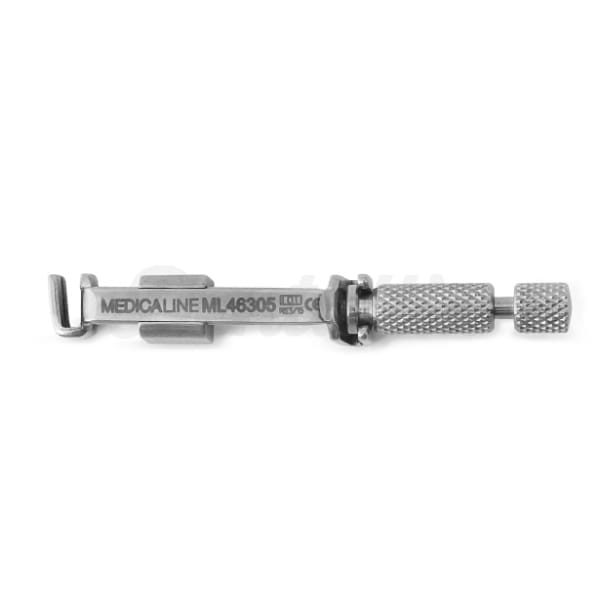
What are sectional matrix systems?
Now let's move on to the latest technology, sectional matrix systems are advanced devices used in restorative dentistry for the precise reconstruction of interproximal contacts in class II restorations. These systems consist of a thin and flexible metal matrix that anatomically adapts to the contour of the tooth, and a series of separating rings that allow for optimal separation of adjacent teeth. The combination of the matrix and the rings ensures a precise contact point and superior marginal adaptation, which facilitates the reconstruction of the proximal anatomy and reduces the risk of over- or under-contouring of the restoration. These systems are especially useful in composite resin procedures, as they provide greater visibility and access to the working area, improving the quality and durability of the final restoration. Would you like to see some examples?
Composi-Tight 3D Fusion Sectional Matrix System by Garrison
Do you have difficult class II cases? The Composi-Tight 3D Fusion sectional matrix system may be the definitive solution for predictable results, and here's why.
The Composi-Tight 3D Fusion sectional matrices provide tight and perfect contacts thanks to their advanced design. Additionally, this system features Soft Face technology rings that help secure the extra-soft matrices to the tooth contour, allowing you to perform a perfect restoration without the matrix moving out of place. This Garrison matrix system is highly intuitive and easy to use, with features that will make your work more efficient.
Composi-Tight 3D Fusion Firm Matrix: Garrison Sectional Matrix Kit
The Composi-Tight 3D Fusion sectional matrix system features three types of rings: the green ring, which is used for wide preparations, including cases where a cusp is missing; the orange ring, which features Ultra-Grip retentive extensions that prevent movement; and finally, the blue ring with reinforced marginal crest on the silicone Soft-Face tips, which is perfect for your cases with short clinical crowns or crowded teeth.
- Easy to use.
- Ultra-Grip retentive tips that prevent ring slippage.
- Matrices are 70% more resistant to deformation than others, while maintaining their thickness of 0.038 mm.
- Solution for all class II cavities.
- Rings are autoclavable.
- Kit includes 3 types of rings, 70 matrices in 5 different sizes, 80 wedges and 4 different sizes, and a forceps for positioning the ring.

Go to Composi-Tight 3D Fusion Garrison 3D Sectional Die System
Garrison's Strata-G Sectional Matrix System
The Garrison Strata-G Sectional Matrix System provides a 270º anatomical Seal that prevents flashing and overcontoured margins.
The Strata-G system has been specifically designed to create perfect anatomical and narrow contact points in Class II composite restorations. The sectional matrix bands ensure reconstruction with appropriate anatomy in the tooth, while the three ring models create the necessary separation between the teeth for band adaptation, resulting in a natural and tight contact.
Strata-G: Garrison Sectional Die Kit
Strata-G rings are designed to perform a wide variety of Class II composite restorations. The kit includes all three types of rings, plus matrix bands in 5 different sizes and 80 wedges in 4 different sizes. In addition, Garrison Premier forceps for positioning the rings.
- Indicated for Class II posterior restorations and wide preparations.
- Rings feature the StrataBond silicone tip for reducing overcontouring.
- Ultra-Grip system that prevents ring movement.
- Highly durable, resistant, and easy-to-open rings, made of nickel titanium and reinforced with Peek.
- Non-stick matrices with improved marginal rim and graduated subgingival extension.
- Strata-G Ultra-Adaptive wedges with wings that adapt to the matrix for a hermetic seal.
- Color-coded system for efficient organization.
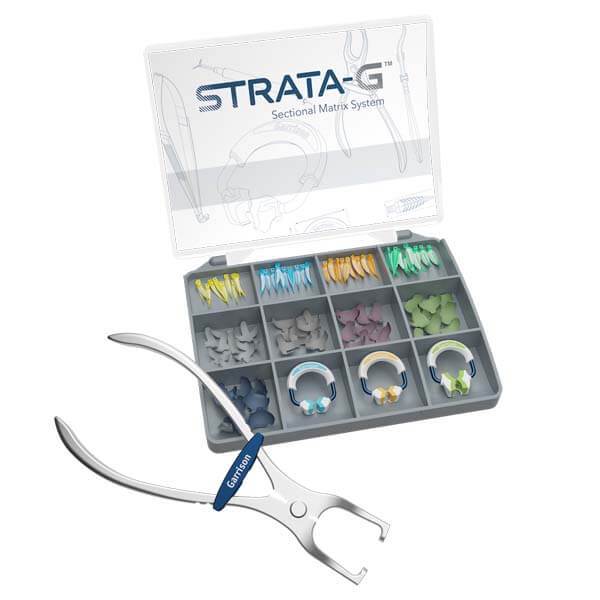
Halo Sectional Matrix System by Ultradent
Ultradent's Halo Sectional Matrix System provides ideal tooth separation, thanks to the design of its ring that adjusts with high precision and the wedge that provides active and always careful separation with soft tissues. Additionally, the bands are perfectly designed to give the tooth a natural contour and thus, provide uniform and precise contact points.
Perhaps the most distinctive advantage of this innovative matrix system is that the wedges are active, that is, they act separating the teeth comfortably for the patient. Another interesting advantage is that the Halo system ring is universal, which means that you only need to use one ring for both molars and premolars.
Halo Sectional Matrix System: Ultradent's Original Band Kit
With the Halo Matrix System, you can create highly anatomical contours in less time, in addition to providing perfectly adjusted contact points thanks to the excellent tooth separation obtained with the nitinol ring and active wedges.
- Easy to use.
- Anatomical restorations.
- Highly durable ring, with memory and resistant to 1000 sterilization cycles.
- Kit includes 2 rings, 25 matrices of each size (5) and 25 wedges of each size (3) and dispenser carousel.
´
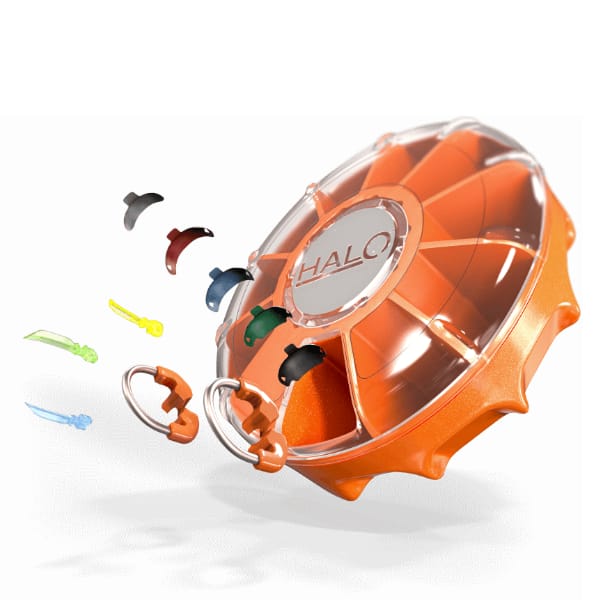
Slick Bands: Garrison Tofflemire style matrix band
.If you are a nostalgic of the Tofflemire system, discover how to perform direct composite veneers in the anterior sector successfully using Slick Bands Tofflemire-style matrices to obtain an appropriate cervical profile and avoid periodontal problems.
The performance of direct composite veneers in the anterior sector represents a significant challenge for dentists, even for the most experienced, due to its high dependence on manual skill. A crucial aspect for the success of these veneers is to achieve an adequate cervical profile, since otherwise periodontal problems such as gingivitis and gingival recession may arise.
There are two main methods for achieving a precise cervical profile: hand modeling, which can be unpredictable and difficult to reproduce, and the use of dental matrices adapted to the neck of the tooth. Although Slick Bands Tofflemire-style matrices are mainly designed for deep margin elevation in the posterior sector, they can also be used effectively in the anterior sector to obtain an anatomical cervical profile in a simple and predictable way.
Using appropriate matrices not only facilitates the restoration process, but also significantly improves the quality and durability of the veneer, ensuring optimal aesthetic and functional results for the patient.
In conclusion, achieving a good point of contact remains one of the greatest challenges in modern restorative dentistry. Fortunately, today we have advanced matrix systems that surpass the traditional Tofflemire matrix retainer, which has drawbacks such as creating little anatomical and straight axial emergence profiles.
Sectional matrix systems are presented as an excellent alternative, offering multiple benefits despite their higher cost. These systems allow for optimal fitting in interproximal spaces, achieving a better point of contact and a more natural and anatomical contour. In this way, they significantly improve the quality of restorations and contribute to the patient's periodontal health.

Remember that at Dentaltix you can find a wide variety of dental matrices and matrix systems of all kinds, as well as all the auxiliary material such as ecological wooden dental wedges Vidu which are a great option.
In addition, of course, you can find very useful instruments such as the Universal Ring Pliers Garrison which has the following features:
- Designed to facilitate the placement of all Garrison rings..
- Holds rings firmly and securely.
- Generates the necessary force to open and position the rings correctly.
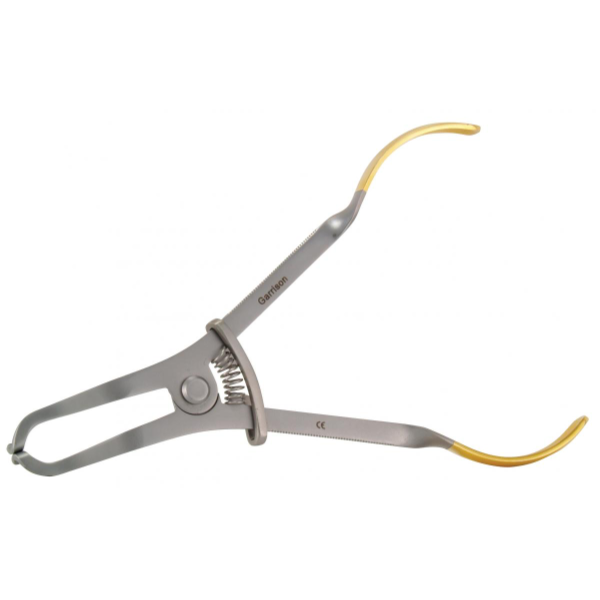
Thank you for reading! Did you like our article? If you want to be always up to date on the latest advances in dentistry, don't forget to follow us on our social networks. For any questions or comments do not hesitate to write us. see you soon!




